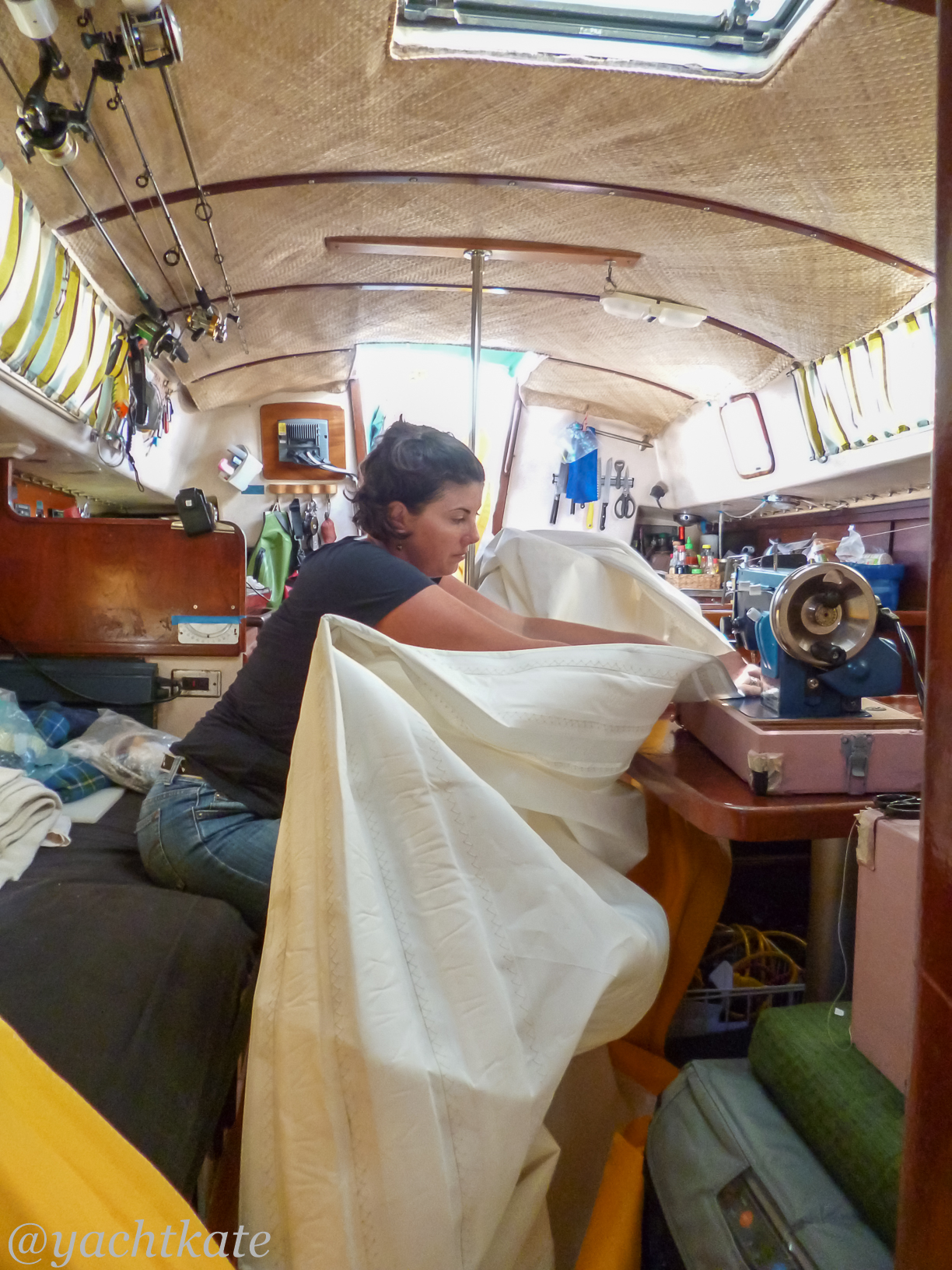The Chicago Yacht Club Race to Mackinac is the longest annual freshwater race in the world. This sailing race, also called “the Mac,” starts at the Chicago Lighthouse and ends at Mackinac Island in Lake Huron, between Michigan’s Upper and Lower Peninsulas. In total, the race stands at 333 miles! More than 350 boats compete every year. Holly Kawula is a loyal Sailrite customer who placed third in her division at the 2018 Mac race, and we wanted to learn a little bit more about her experience racing using a sail made from one of our Sail Kits.
Q: What’s your history with sailing? Has it been an ongoing hobby for you?
My husband Walter and I bought our first sailboat for daysailing/cruising 24 years ago. We are now on our third boat. Walter had become interested in racing through a co-worker back in 2000, and was specifically looking for a racing boat when he found Truant in 2004. Truant is a 1985 S2 9.1, manufactured in Holland, Michigan, and designed for sailing the Great Lakes. I was somewhat busy at the time with our four young children, but after one memorable evening out for a Wednesday night Beer Can, I was hooked on racing. I also realized that if I wanted to spend any time with Walter on weekends or Wednesday nights I needed to learn not only how to sail but how to be a part of a competitive racing crew. Truant began an earnest racing program in 2006.
Walter and I are watch captains, and our other crew included our foredeck, Chad Goldenberg and Beth Cushing, and our helm/trimmers/back of the boat Brad and Gretchen Horn. Chad has been with us for six years, Brad has been with us for five years, Gretchen is new to our crew this year, and Beth is a long-time friend and guest crew (this was her second Mac with us).

Q: How did you prepare?
This was our sixth Mac race. We have long-term/ongoing preparation, which involves recruiting and developing our crew and participating in as many long-distance races as we can; mid-term preparation, which involves this season’s boat maintenance, sail and safety equipment repair and/or replacement; and short-term, which includes readying the boat for three to four days of non-stop sailing for a crew of six. Space is at a premium on our 30-foot boat, so we clear out any unnecessary gear, rig our lee cloths for storage on our lower berths (made with materials from Sailrite), prepare and freeze meals for the journey, etc.
Q: Do you have any exciting stories from the race? Did you have any mishaps or hardships you had to overcome?
Hardship? On this year’s race, the high winds and high sea state (waves) for the first 36 hours were staggering. We’ve been through some really rough storms before, including last year’s “dry heat burst” on the Mac (sudden unexpected onset of 45+ knot winds), which shredded our spinnaker, caused us to round up, our toe-rail to fail, and caused the lifelines to rip a stanchion out of our deck and leave a fist-sized hole. While all this was happening, our crew dropped our brand new unhoisted #3 headsail overboard and then, of course, we abandoned the race. That whole incident took place over less than 15 minutes, and then the winds calmed down.
This year, we were facing not a storm but a steady system of 15-25 knot winds and 6-8 foot waves over two days. The conditions at the start were like nothing I’ve ever seen before. Water was continually washing over the decks and leaking into the cabin. It was also raining. We were all wearing full foul weather gear, personal flotation devices, and tethers, plus were still soaked to the skin. Maintaining control of the helm required physical stamina I didn’t know I had. Sitting (bouncing, pounding) on the rail required a great deal of stamina as well, as we were crashing into waves and continually washed over with waves. Then there was nightfall, with no moon or starlight and we were doing it all blindly.
Q: You utilized one of our sail kits to build your own sail. What did you gain or learn from this?
A couple of weeks before the Mac race last year we realized that our infrequently used #3 headsail was no longer serviceable. Flaking it after a race, we found our hands were literally going through the degraded laminate. There was no time to order a new one from our supplier, so the Sailrite kit was our only option. I requested the estimate, placed the order, and the kit arrived at noon on Wednesday before the Saturday of the Mac.
My family and my crew worked as a team for the next two days to put it together, and that’s the most valuable take away I had from the experience. It required a lot of patience and cooperation, and everyone stepped up to the challenge. The sense of accomplishment when we completed it early Friday evening before the race was something I’ll always treasure. We laid it out on our front lawn to put the telltales, amazed that we had made a REAL SAIL and opened a bottle of champagne to celebrate.
Q: After building your own sail do you feel more confident when it comes to repairs and overall sail maintenance?
I do feel more confident in repairs and maintenance. For example, I replaced the leech line and tape on our mainsail this spring without hesitation or intimidation.
Q: Did you feel confident you were getting the proper sail for your boat/conditions after speaking to Sailrite?
Jeff Frank gave me all the information I needed/asked for before ordering so I had no concerns about whether or not I was getting the proper sail.
Q: How was the overall ordering process?
The overall ordering process was a breeze!
Q: Would you recommend building a sail to a friend?
I would absolutely recommend building a sail to friends, and I have.
Q: What tools/supplies did you find most useful while building the sail?
Regarding tools, of course first and foremost was the Sailrite® Ultrafeed®, then the two-sided tape. We made extensive use of clamps as well.
Q: Did you save any money?
We did save a considerable amount of money providing our own labor both times we made the sail. But we didn’t sacrifice any quality, as it’s a great sail and it’s serving us very well. I’ve attached a photo of our crew at the podium after the Mac this year, for which we used our #3 headsail for the first half of the race.
Q: Overall, what did you take away from this entire experience?
You know what the best part of this was? We did it. And, as you can see by the smiles on our faces at our podium finish, we’d do it again. Long-distance races like the Mac don’t just require skilled crew, they require a committed team willing to endure hardship and support each other. Having a good finish also requires that crew not only endure but persist, keep trimming sails, stay focused and stay competitive.
Who We Are
Sailrite is your one-stop DIY shop! We are a passionate crew of do-it-yourselfers who strive to equip you with the supplies and how-to knowledge you need to tackle your next project. Do you want to learn upholstery, leatherwork, canvaswork, hobby sewing, bag making or more? We have the fabric, tools, hardware, sewing machines and notions you need to master any DIY. And even if you’ve never sewn before, our tutorials and how-to videos are designed for beginners and experienced crafters alike.
Start your DIY journey today: www.sailrite.com




